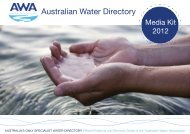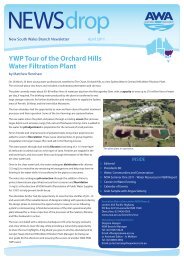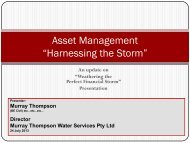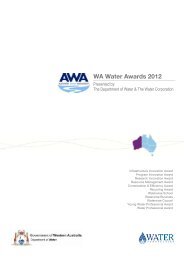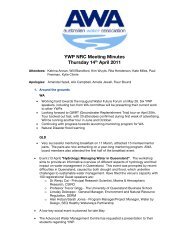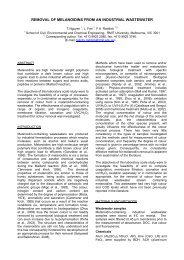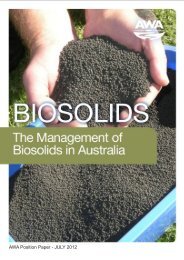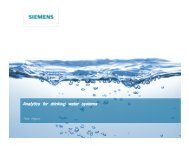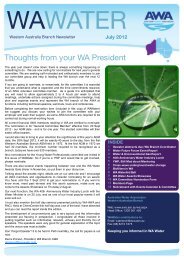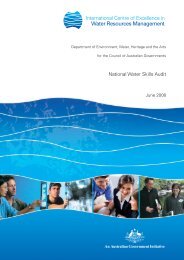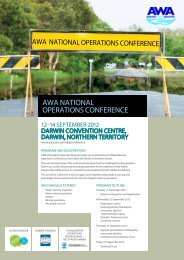Optimum Use of Subsidies for Reducing Domestic Water Consumption
Optimum Use of Subsidies for Reducing Domestic Water Consumption
Optimum Use of Subsidies for Reducing Domestic Water Consumption
You also want an ePaper? Increase the reach of your titles
YUMPU automatically turns print PDFs into web optimized ePapers that Google loves.
many rebates were paid to home owners<br />
compared to renters <strong>for</strong> dual-flush toilets and<br />
rainwater tanks. Even <strong>for</strong> low-flow showerheads,<br />
which have minimal installation difficulty and low<br />
capital costs, uptake was 16 times higher (3.93% v<br />
0.24%) in the home owner group compared to the<br />
tenant group. Washing machines were the only<br />
measure with higher uptake in the tenant group<br />
compared to the home owner group. Over the five<br />
year H 2 OME program, approximately 1 in 3 tenants<br />
claimed a rebate <strong>for</strong> the purchase <strong>of</strong> a new<br />
washing machine compared to only 1 in 5 home<br />
owners in South Australia. Regression analyses <strong>of</strong><br />
postcode median aggregate income against the<br />
postcodes <strong>of</strong> rebate applicants accept, at the 5%<br />
level, a null hypothesis that income is not an<br />
influence on rebate program participation.<br />
Together, these results have implication <strong>for</strong><br />
efficient policy <strong>for</strong>mulation.<br />
We infer that the adoption <strong>of</strong> water saving<br />
measures which do not add to consumer utility<br />
beyond a water saving benefit – low-flow<br />
showerheads and dual-flush toilets – are limited<br />
amongst groups with minimal financial incentive 1 to<br />
save water. On the other hand, rebate uptake <strong>for</strong><br />
measures that add a utility externality beyond<br />
water efficiency – washing machines – is relatively<br />
independent <strong>of</strong> the financial motivation <strong>for</strong> reducing<br />
domestic water consumption. It may be that<br />
subsidies <strong>for</strong> washing machines are being paid to<br />
consumers who have already made a purchasing<br />
decision independent <strong>of</strong> rebate incentive. This<br />
leads to Pareto inefficiency caused by the free<br />
rider problem. Subsidy levels <strong>for</strong> measures like<br />
washing machines need to be set at the typical<br />
price differential between WELS 4-star appliances<br />
and more inefficient models.<br />
By June 2011, many programs had ended or been<br />
scaled back. Results <strong>of</strong> our cost efficiency analysis<br />
identified that in the South Australian scheme lowflow<br />
showerheads, pool covers and front-loader<br />
washing machines rebates were able to achieve<br />
levelised unit costs to the Policymaker <strong>of</strong> $0.45/kL,<br />
$2.03kL and $2.38/kL – all less than the $2.40/kL<br />
long run marginal cost <strong>of</strong> potable water – as shown<br />
in Figure 1. Similarly, the role <strong>of</strong> a rebate reduces<br />
the payback period <strong>of</strong> a 1kL standalone rainwater<br />
tank and dual flush toilet by 10 and 8 years<br />
respectively. From the perspective <strong>of</strong> the<br />
consumer, only low-flow showerhead rebates<br />
allowed water savings to be achieved below the<br />
$2.48/kL tariff block at which most households are<br />
charged.<br />
While rebate programs have proved popular,<br />
questions can be raised about whether their costefficiency<br />
could have been improved by altering<br />
1 Landlords, rather than tenants in South Australia, generally<br />
pay the water supply and first 136kL <strong>of</strong> volumetric tariff<br />
charge.<br />
the combination and rebate level <strong>of</strong> water saving<br />
measures. A $150 rebate <strong>for</strong> a single dual flush<br />
toilet has the opportunity cost to policymakers <strong>of</strong><br />
subsidising five low-flow showerheads at $30 each.<br />
Would subsidising only the most cost efficient<br />
measures such as low-flow showerheads produce<br />
meaningful volumes <strong>of</strong> yield What combination <strong>of</strong><br />
subsidy level would generate sufficient uptake to<br />
deliver water savings at or below the long run<br />
marginal cost <strong>of</strong> supply The first question requires<br />
estimates <strong>of</strong> uptake response whilst the second<br />
question represents a decision space <strong>of</strong> order 10 11<br />
combinations <strong>for</strong> 20 common measures and 9<br />
possible prices.<br />
METHOD: A NEW FRAMEWORK FOR PARETO<br />
EFFICIENT REBATE POLICY<br />
A review <strong>of</strong> Australian examples identifies that<br />
policymakers exert influence over the response <strong>of</strong><br />
consumers to a rebate program through a number<br />
<strong>of</strong> policy decisions. These decision variables<br />
include the measures which should be included in<br />
a rebate program, the level <strong>of</strong> rebate <strong>for</strong> these<br />
measures, the duration <strong>of</strong> the program, the<br />
intensity and timing <strong>of</strong> advertising campaigns and<br />
the conditions attached to rebate eligibility.<br />
Additionally, a number <strong>of</strong> conditions outside the<br />
control <strong>of</strong> policymakers influence the uptake and<br />
subsequently, the water saving and cost response.<br />
Based on data constraints, our analysis simplifies<br />
the problem and decision space – policymakers<br />
are assumed to influence uptake through only two<br />
decisions - whether or not to subsidise a measure<br />
and the level at which a subsidy should <strong>of</strong>fered <strong>for</strong><br />
that measure.<br />
Our approach investigates the trade-<strong>of</strong>f that exists<br />
between how much a policymaker is willing to<br />
spend and the volume <strong>of</strong> water savings that can be<br />
achieved <strong>for</strong> different rebate policy combinations.<br />
Using the understanding gained from the analysis<br />
<strong>of</strong> Australian rebate uptake, paired with original<br />
estimates <strong>of</strong> water savings; three models – uptake,<br />
water savings and cost – are proposed to evaluate<br />
conflicting objectives seeking to<br />
1) minimise the cost <strong>of</strong> the rebate program<br />
2) maximise the volume <strong>of</strong> water savings<br />
A genetic algorithm, NSGA-II (Deb et al., 2002) in<br />
a spreadsheet-based implementation (Savic et al.,<br />
2011) is applied to develop the Pareto frontier <strong>of</strong> all<br />
non-dominated combinations <strong>of</strong> rebate policy. The<br />
two decision variables – whether or not a rebate<br />
should be <strong>of</strong>fered <strong>for</strong> a given measure; and the<br />
level at which a rebate <strong>for</strong> that measure should be<br />
<strong>of</strong>fered – are represented in the chromosome <strong>of</strong><br />
the genetic algorithm. This chromosome <strong>of</strong> 20-bit<br />
length is <strong>for</strong>mulated using integer coding with each<br />
bit representing a different water saving measure.<br />
These include four „non-tank‟ measures – low-flow<br />
showerheads, dual flush toilets, 4-star washing



